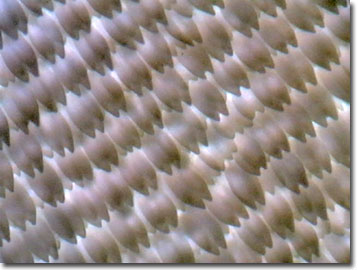Darkfield Digital Image Gallery
Monarch Butterfly (Danaus plexippus) Wing
As the common name implies, the monarch butterfly (Danaus plexippus) is the king of the insect order Lepidoptera. Known throughout North America, these colorful butterflies are able to migrate long distances (up to 3,000 miles) in round-trips to winter roosts in Mexico and California. Their migration is monitored by students through Monarch Watch, an international tagging program based at the University of Kansas in Lawrence, and using numbered, 9-millimeter-diameter round, polypropylene tags placed on the underside of hindwings.

View a low magnification image of a monarch butterfly (Danaus plexippus) wing.
View a high magnification image of a monarch butterfly (Danaus plexippus) wing.
As with most butterflies, monarchs go through an egg, larval (caterpillar), pupal (chrysalis), and adult life stage which may take 1.5 to 9 months to complete. The eggs are surrounded by the chorion, a hard outer shell, which is lined with a wax layer that prevents desiccation. Because the shell of the egg is hard before fertilization, a funnel-shaped opening (micropyle) forms at one end to allow sperm penetration. The caterpillars of D. plexippus feed mainly on milkweed species. Milkweed sap contains poisonous cardenolides (or cardiac glycosides) that creates a bitter taste to discourage herbivores and which are poisonous to vertebrates. As one of the milkweed butterflies, monarch caterpillars have built-in biochemical mechanisms for taking in the toxin and storing it in their tissue, making the caterpillar, chrysalis, and flying adult distasteful and toxic to potential predators such as birds.
However, just being toxic does not help an individual butterfly after it has been killed and the predator attempts to eat it. Rather, the adult butterfly offers bright warning coloration of yellow, orange, black, and white through their wing scales. Large wings help monarch butterflies escape predatory attempts relatively unharmed, perhaps with a beak-sized section removed. One bite of the distasteful cardenolides may discourage the killing and eating of the adult butterfly. Many insectivorous birds such as blue jays learn quickly from their very bitter mistakes, and do not attempt them again without facing nausea and other ill effects. Interestingly, some butterfly species that do not feed on and store the milkweed's toxins use Batesian mimicry to take advantage of the predator protection afforded by the monarch's wing patterns and warning coloration.
Emerging from the pupal stage, the adult butterfly inflates its wings by sixty-fold with a pool of blood, which it stored in its abdomen. Excess fluids are expelled, the butterfly rests and waits for its wings to stiffen and dry, before it attempts flight and the life cycle is reinitiated. The wing venation patterns and shape of genitalia are important key characteristics for lepidopterists. Male monarchs are distinguished from female monarch butterflies by their thinner wing vein pigmentation and the appearance of swollen pouches (black spots) on their hindwings. Wing scales, usually held at 45-degree angles to the wing membrane, are either ground scales responsible for background colors or cover scales that are usually larger and bear the main pattern elements of the wing design through optical interference or pigmentation. The dense mosaic of colorless and pigmented scales of the wings are responsible for the wide variety of patterns and colors afforded the great diversity of butterfly species, ensuring species recognition for successful reproduction, and as in the case of the monarch butterfly, improved survival because of warning coloration. Other species use their wing patterns and coloration for camouflage, another survival tactic dependent on the wing scales and how they reflect and refract incident light. With butterflies, the underside of the wing commonly shows the camouflage coloration, because when at rest, these primarily daylight lepidopterans fold their wings up and over their bodies. This contrasts with their moth relatives that are nocturnal, and which usually rest with their wings flattened.
Contributing Authors
Cynthia D. Kelly, Thomas J. Fellers and Michael W. Davidson - National High Magnetic Field Laboratory, 1800 East Paul Dirac Dr., The Florida State University, Tallahassee, Florida, 32310.
BACK TO THE DARKFIELD IMAGE GALLERY
BACK TO THE DIGITAL IMAGE GALLERIES
Questions or comments? Send us an email.
© 1995-2025 by Michael W. Davidson and The Florida State University. All Rights Reserved. No images, graphics, software, scripts, or applets may be reproduced or used in any manner without permission from the copyright holders. Use of this website means you agree to all of the Legal Terms and Conditions set forth by the owners.
This website is maintained by our
Graphics & Web Programming Team
in collaboration with Optical Microscopy at the
National High Magnetic Field Laboratory.
Last Modification Friday, Nov 13, 2015 at 01:19 PM
Access Count Since September 17, 2002: 8091
Visit the website of our partner in introductory microscopy education:
|
|
